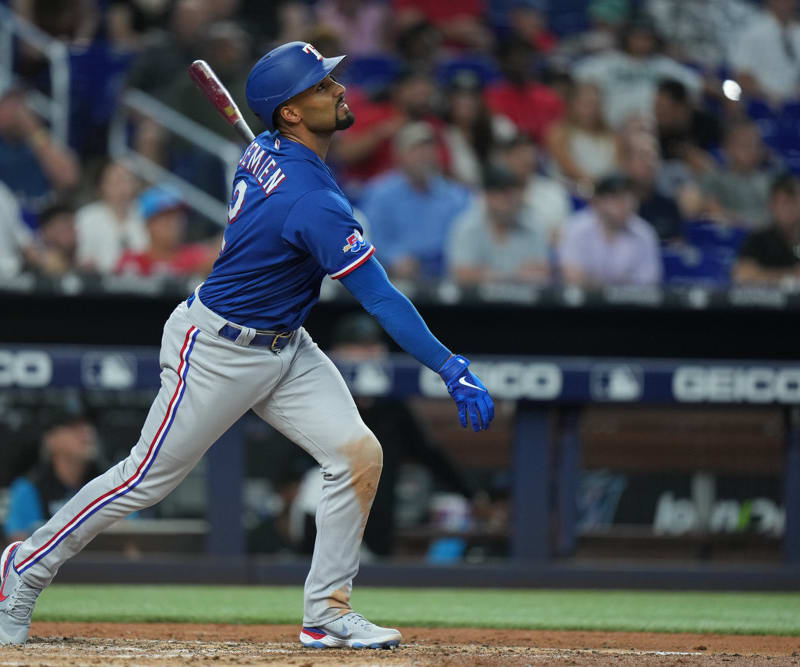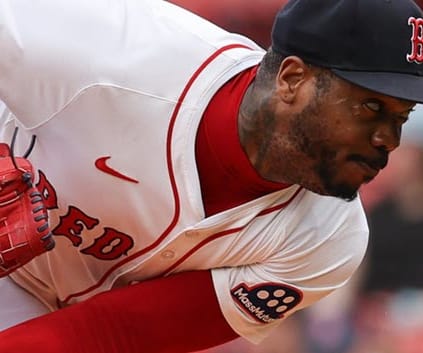2025 Stats
W-L
5-3
ERA
1.17
WHIP
0.70
K
85
SV
32
2026 Projections
2026 Fantasy Outlook
During his age-37 season, Chapman dominated opposing hitters en-route to a league-best 1.17 ERA and 0.70 WHIP across 61.1 innings. Chapman's 37.3 percent strikeout rate ranked third among qualified relievers, and perhaps most remarkably, he delivered the best walk rate (6.6 percent) of his 16-year career. This amounted to a 30.7 percent K-BB percentage that ranked second. Not to mention, the southpaw racked up 32 saves (T-5th) that were his most in a season since 2019. Chapman's strong performance earned him a $13.3M contract extension with the Red Sox that will keep him in Boston for at least one additional season. He has a vesting option for 2027 based on innings pitched, which becomes a mutual option if not triggered during the upcoming campaign. Expect some ratio regression in 2026, but it's clear Father Time has not caught up with Chapman yet. On average, the electric hurler has been the 7th closer off the board in early 2026 drafts. Read Past Outlooks

Picks up four-out save
Chapman gave up three hits while striking out two batters across 1.1 scoreless innings to record the save in Tuesday's 3-1 win over the Yankees. He did not issue a walk.
Analysis
With Boston up two runs entering the bottom of the ninth, Chapman made things interesting by allowing three consecutive singles to Paul Goldschmidt, Aaron Judge and Cody Bellinger to begin the inning. The veteran reliever then retired the next three batters he faced to preserve the win and secure the 11th postseason save of his career. After posting a career-best 1.17 ERA and 0.70 WHIP during the regular season, Chapman is a safe bet to receive the vast majority of save opportunities for the duration of the BoSox's postseason run.
With Boston up two runs entering the bottom of the ninth, Chapman made things interesting by allowing three consecutive singles to Paul Goldschmidt, Aaron Judge and Cody Bellinger to begin the inning. The veteran reliever then retired the next three batters he faced to preserve the win and secure the 11th postseason save of his career. After posting a career-best 1.17 ERA and 0.70 WHIP during the regular season, Chapman is a safe bet to receive the vast majority of save opportunities for the duration of the BoSox's postseason run.
Pitching Stats
Loading Pitching Stats...
2025 MLB Game Log
2025
2024
2023
2022
2021
2020
2019
2018
2017
Minor League Game Log
Calculate Stats Over Time
Just click on any two dates.
Loading Minor League Pitching Game Log...
Pitching Appearances Breakdown
Average Pitch Count
14
Last 10 Games
19
Last 5 Games
20
How many pitches does Aroldis Chapman generally throw?
1-10
11-20
21-30
31-40
41-50
51-60
61-70
71-80
81-90
91-100
101-110
111-120
121+
What part of the game does Aroldis Chapman generally pitch?
1st
2nd
3rd
4th
5th
6th
7th
8th
9th
Extra
% Games Reaching Innings Threshold
% Games By Number of Innings Pitched
Left/Right Pitching Splits
Since 2023
-18%
BAA vs RHP
2025
-14%
BAA vs RHP
| BAA | K | BB | H | HR | ||||
|---|---|---|---|---|---|---|---|---|
| Since 2023vs Left | .196 | 61 | 25 | 29 | 2 | |||
| Since 2023vs Right | .161 | 225 | 65 | 80 | 10 | |||
| 2025vs Left | .148 | 23 | 1 | 8 | 1 | |||
| 2025vs Right | .127 | 62 | 14 | 20 | 2 | |||
| 2024vs Left | .211 | 21 | 14 | 12 | 1 | |||
| 2024vs Right | .194 | 77 | 25 | 32 | 4 | |||
| 2023vs Left | .243 | 17 | 10 | 9 | 0 | |||
| 2023vs Right | .161 | 86 | 26 | 28 | 4 | |||
| More Splits→ | View More Split Stats | |||||||
Home/Away Pitching Splits
Since 2023
-20%
ERA on Road
2025
-40%
ERA at Home
| ERA | WHIP | IP | K/9 | BB/9 | |||||
|---|---|---|---|---|---|---|---|---|---|
| Since 2023Home | 2.96 | 1.22 | 97.1 | 14.4 | 4.3 | ||||
| Since 2023Away | 2.36 | 0.95 | 84.0 | 13.9 | 4.6 | ||||
| 2025Home | 0.88 | 0.72 | 30.2 | 12.0 | 2.3 | ||||
| 2025Away | 1.47 | 0.68 | 30.2 | 12.9 | 2.1 | ||||
| 2024Home | 5.50 | 1.75 | 34.1 | 16.0 | 6.6 | ||||
| 2024Away | 1.65 | 0.84 | 27.1 | 12.2 | 4.6 | ||||
| 2023Home | 2.23 | 1.14 | 32.1 | 15.0 | 3.9 | ||||
| 2023Away | 4.15 | 1.38 | 26.0 | 17.0 | 7.6 | ||||
| More Splits→ | View More Split Stats | ||||||||
Stat Review
How does Aroldis Chapman compare to other relievers?
This section compares his stats with all relief pitcher seasons from the previous three seasons (minimum 30 innings)*. The bar represents the player's percentile rank. For example, if the bar is halfway across, then the player falls into the 50th percentile for that stat and it would be considered average.
* Exit Velocity, Barrels/BBE %, Balls Hit 95+ MPH %, and Spin Rate are benchmarked against 2019 data (min 30 IP). See here for more exit velocity/barrels stats plus an explanation of current limitations with that data set.
* Exit Velocity, Barrels/BBE %, Balls Hit 95+ MPH %, and Spin Rate are benchmarked against 2019 data (min 30 IP). See here for more exit velocity/barrels stats plus an explanation of current limitations with that data set.
K/BB
5.67K/9
12.5BB/9
2.2HR/9
0.4Fastball
99.3 mphERA
1.17WHIP
0.70BABIP
.221GB/FB
1.00Left On Base
87.6%Exit Velocity
82.2 mphBarrels/BBE
3.2%Spin Rate
2310 rpmBalls Hit 95+ MPH
16.3%Swinging Strike
19.0%Advanced Pitching Stats
Loading Advanced Pitching Stats...
Defensive Stats
Loading MLB Defensive Stats...
Stats Vs Today's Lineup
Want more matchup stats?
Loading Matchup Stats...
Our full team depth charts are reserved for RotoWire subscribers.
Subscribe Now
Past Fantasy Outlooks
2025
2024
2023
2022
2021
2020
2019
2018
2017
2016
2015
2014
2013
2012
2011
2010
Control continues to be a major issue for Chapman, who issued 39 free passes over 61.2 innings with the Pirates in 2024. His 14.7 percent walk rate was the worst among qualified relievers, but he still posted an impressive 22.3 K-BB percentage that was a top-25 mark. The veteran southpaw averaged 99.8 miles per hour on his sinker, inducing a 32 percent whiff rate that is consistently near the top of the leaderboard for that pitch type. He struck out 98 batters and racked up 14 saves, proving he can still get the job done in the ninth inning. Chapman, who will turn 37 years old in February, signed a one-year, $10.75 million deal with Boston. He'll be a candidate to close for the Red Sox alongside Liam Hendriks and Justin Slaten.
More Fantasy News

Locks down 32nd save
Chapman worked a perfect ninth inning Tuesday without striking out a batter to record his 32nd save of the season in a 4-1 win over the Blue Jays.
Analysis
Subscribe now to instantly reveal our take on this news.
Subscribe now to instantly reveal our take on this news.

Records 31st save
Chapman earned the save Saturday against the Rays, walking one and striking out one in a scoreless ninth inning.
Analysis
Subscribe now to instantly reveal our take on this news.
Subscribe now to instantly reveal our take on this news.

Reaches 30-save mark
Chapman struck out one in a perfect inning to earn the save in Sunday's 6-4 win over the Yankees.
Analysis
Subscribe now to instantly reveal our take on this news.
Subscribe now to instantly reveal our take on this news.

Takes first loss since May
Chapman (4-3) took the loss Wednesday against the A's, allowing a run on two hits in one-third of an inning.
Analysis
Subscribe now to instantly reveal our take on this news.
Subscribe now to instantly reveal our take on this news.

Rare four-strikeout inning in save
Chapman struck out four in a scoreless and hitless inning to earn the save in Sunday's 7-4 win over the Diamondbacks.
Analysis
Subscribe now to instantly reveal our take on this news.
Subscribe now to instantly reveal our take on this news.
Latest Fantasy Rumors

Wins accolade in American League
Chapman has been named the American League Reliever of the Month for August, Jason Foster of MLB.com reports.
Analysis
Chapman didn't allow a single hit in any of his 12 outings in August, covering 11 innings. He surrendered only one walk, during an Aug. 19 outing against the Orioles, but other than that, he was perfect. Some additional proff of how unhittable Chapman was in August was that opponents had an average exit velocity of just 84.4 mph when putting the ball in play. Chapman hasn't blown a save since July 23, with his 28 saves this year being his highest total since 2021.
Chapman didn't allow a single hit in any of his 12 outings in August, covering 11 innings. He surrendered only one walk, during an Aug. 19 outing against the Orioles, but other than that, he was perfect. Some additional proff of how unhittable Chapman was in August was that opponents had an average exit velocity of just 84.4 mph when putting the ball in play. Chapman hasn't blown a save since July 23, with his 28 saves this year being his highest total since 2021.















